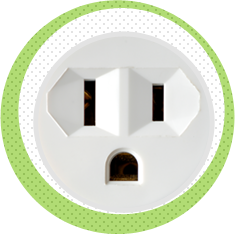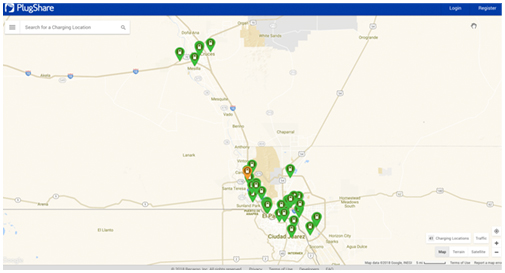Charge at Home
While there are several ways to charge your EV, charging at home is often the lowest cost and most convenient option. There are two kinds of at home charging: Level 1 and Level 2. Which one is right for you?
 Level 1 Charging:
Level 1 Charging:
Uses the charge cord that came with your EV and plugs in to a 120-volt outlet. To avoid tripping a circuit breaker, the charger should not be plugged in the same outlet as any other major appliances (refrigerator, A/C, washing machine). The Level 1 charge rate is approximately 5 miles of range per hour of charge – or roughly 60 miles of recharge each night. No separate charging station is required, which avoids the expense of a dedicated 240-volt circuit and more expensive equipment.
 Level 2 Charging:
Level 2 Charging:
Requires installation of a charging station connected to a 240-volt outlet. Charging at Level 2 can add roughly 10 to 30 miles of range per hour, depending on the vehicle, which is 5-7 times faster for all-electric vehicles than level 1 charger (using traditional 120-volt outlet). While the faster recharge time may be more desirable, in some instances, a panel upgrade and service upgrade from EPE may be required. A licensed electrician should be consulted to determine if the home’s existing panel can accommodate Level 2 charging, as well as the related costs to install a 240-volt outlet in the garage.
Public Charging
 There are over 100 public charging stations in El Paso Electric’s service territory. Public stations can be Level 1, Level 2 or Level 3. Level 3 or “DC fast charging” can recharge up to 80% of your battery in 20 minutes. You can find public charging stations near you by visiting PlugShare or downloading its mobile app in the iOS App Store or Google Play Store.
There are over 100 public charging stations in El Paso Electric’s service territory. Public stations can be Level 1, Level 2 or Level 3. Level 3 or “DC fast charging” can recharge up to 80% of your battery in 20 minutes. You can find public charging stations near you by visiting PlugShare or downloading its mobile app in the iOS App Store or Google Play Store.
Workplace Charging
Show your appreciation to your employees and customers by giving them an opportunity to charge their EV at work. Workplace charging may help improve your business image and strengthen your brand name by demonstrating leadership and commitment to the environment, employees and customers, and emergent technology. When setting up workplace charging, it’s important to choose the right charger, installer, and set up a charging plan and policy that best fits your business’s needs.
Here are some steps that may guide you to enabling workplace charging at your business:
1. Drive the momentum
- Identify employee and customer interest;
- Get familiar with grants, charging providers, special charging rates available, and costs;
- Speak with all relevant stakeholders; and
- Contact El Paso Electric for more information.
2. Select an EV charging provider that best fits your need
- Make sure the charging equipment is compatible with most electric vehicles;
- Identify user-friendly charging equipment; and
- Make sure charging equipment meets the business, city, and EPE’s safety requirements.
3. Hire a certified and experienced installer
4. Develop a charging policy
- Instructions on how to use the charging equipment;
- Develop rules and charging etiquette; and
- Set a payment plan for charging.
Multi-Unit Dwelling Charging
Charging equipment designed for Multifamily buildings, such as apartments or condos, can provide a solution to residents who may not have access to home charging. Property owners that invest in Multifamily charging may attract and retain residents while promoting an environmentally-friendly community. When setting up Multifamily charging, it’s important to consider parking and electrical service access, installation and operating costs, and legalities between the property owner and EV resident.
Here are some steps that may guide you to enabling Multifamily charging at your property/housing unit:
1. Drive the momentum
- Identify resident/tenant/property owner interest;
- Get familiar with grants, charging providers, special charging rates available, and costs;
- Speak with all relevant stakeholders; and
- Contact El Paso Electric for more information.
2. Determine charging equipment ownership
- Will the charging equipment be owned by the resident, the property owner, or a third-party vendor?
3. Select an EV charging provider that best suits your needs
- Make sure the charging equipment is compatible with the most electric vehicles;
- Identify user-friendly charging equipment; and
- Make sure charging equipment meets the property owner, city, and EPE’s safety requirements.
4. Allocate cost of installation and operation
- Set a clear payment plan for charging and recovering cost of installation.
- Ex: fixed parking fee, prepaid subscription, etc.
- Ex: fixed parking fee, prepaid subscription, etc.
5. Establish parking and electrical service access
- Will the electric service be metered to the property owner or directly to the resident’s electric bill?
- Will the designated parking space have access to electricity or will upgrades have to be made?
6. Hire a certified and experienced installer
7. Develop a charging policy
- Instructions on how to use the charging equipment; and
- Develop rules and charging etiquette.
Public Transit and Customer Fleet Charging
Electrification of fleets for public transit, municipal and customer fleets have numerous societal and economic benefits. When compared to gasoline/diesel vehicles, electric buses are quieter which reduces noise pollution, have zero-emissions to improve local air quality, and are mechanically simpler, meaning less maintenance and result in reduced operating costs.
Here are some steps that may guide you to enabling fleet charging:
1. Drive the momentum
- Identify interest;
- Get familiar with grants, charging providers, special charging rates available, and costs;
- Speak with all relevant stakeholders; and
- Contact El Paso Electric for more information.
2. Select an EV charging provider that best suits your needs
- Make sure the charging equipment is compatible with your fleet of electric vehicles;
- Identify user-friendly charging equipment; and
- Make sure charging equipment meets your entity, city, and EPE’s safety requirements.
3. Hire a certified and experienced installer
4. Develop a charging policy
- Instructions on how to use the charging equipment; and
- Develop rules and charging etiquette.
Contact us at customercare@epelectric.com or (915) 543-5970
